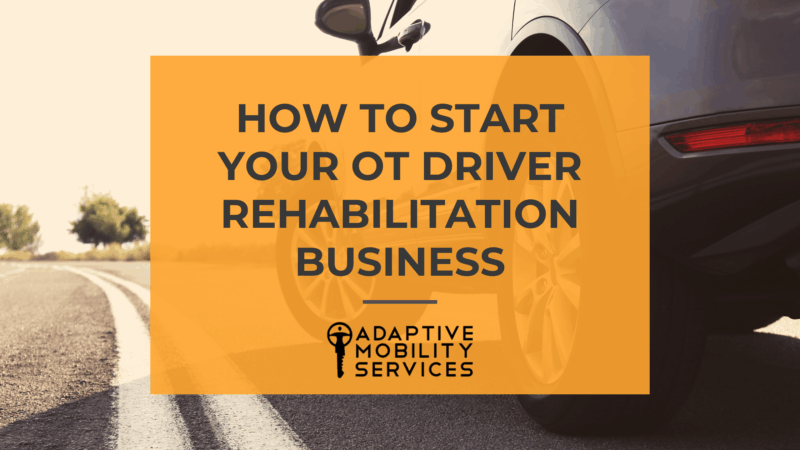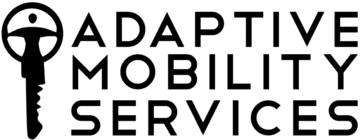
How To Start Your OT Driver Rehabilitation Business
Starting your own driver rehabilitation business allows you to help clients safely return to driving. It is also a rewarding, flexible career in occupational therapy (OT). Steps to starting your own OT driver rehabilitation business include:
- Working with Adaptive Mobility for ongoing education
- Understanding your state licensing laws
- Securing a specialized vehicle with adaptive equipment
- Obtaining specialized insurance
- Creating your business structure
- Utilizing a HIPAA-compliant EMR
- Knowing your associations and guiding documents
- Working with Adaptive Mobility as a mentor
Read on to gain an overarching understanding of each of these pieces of the puzzle.
1. Work With Adaptive Mobility For Ongoing Education
Specialized education is essential for safety and to gain confidence in providing driver rehabilitation. Adaptive Mobility offers advanced, OT-specific driver rehab training that prepares you for participating in hands-on clinical experiences, making use of adaptive equipment, and navigating on-road instruction. This hands-on, OT-focused approach ensures the training is directly relevant to occupational therapy practice and offers specialized, practical skills rather than general medical information, making it a clear advantage over other programs. Susie Touchinsky at Adaptive Mobility offers courses to ensure you have access to ongoing education and are refreshed often with the latest best practices in the field. This will set a strong foundation for your business.
2. Understand Your State Licensing Laws
Driver rehabilitation is regulated differently in each state. It is absolutely critical to know your specific licensing requirements. Contact your state’s department of transportation medical advisory board to confirm what is required for OT professionals in the world of driver rehab. Since driver rehab is regulated differently in each state, licensing laws will vary depending on the state you work in and who you are working with. Becoming a driving instructor or driving school may be required if you are working with new drivers, but may not be needed for licensed drivers. Ask what documentation you need to legally provide services as well as protect yourself and your clients. You will also want to understand your state’s medical reporting process and your role.
3. Secure a Specialized Vehicle With Adaptive Equipment
A safe and effective driver rehab business requires a specialized vehicle equipped for on-road training. This includes an instructor brake, specialized mirrors, and may also include adaptive equipment tailored to client needs. You may also need practical tools like whiteboards and dry-erase markers for in-car instruction. It is good practice to partner with a qualified mobility dealer to be sure that your vehicle meets state requirements and best serves your patients. The National Mobility Equipment Dealership Association has a directory for finding a QAP or Qualified Approved Provider for specialized vehicle installation.
4. Obtain Specialized Insurance
Driver rehab requires more than just general OT liability insurance. Beyond that, you need specialized coverage for your vehicle and your driver rehab services. Confirm that the vehicle, instructor, and client are all covered during on-road instruction and assessments. Work with an insurance agent who is familiar with driver rehab to verify that you have the right policies to protect everyone.
5. Create Your Business Structure
Forming a business structure and opening a business bank account to separate personal and business finances are a great way to begin and set your business up for success. Partnering with a small business attorney to help with contracts and liability protections is strongly recommended. You can learn to keep your books accurately yourself or even partner with a small business accountant who understands private practices to efficiently maintain clean financial records.
6. Utilize a HIPAA-Compliant EMR
A good electronic medical record (EMR) system is essential for effectively managing your driver rehab practice. Look for an EMR that is HIPAA-compliant. Automated scheduling and appointment reminders are another amazing feature that make your life easier and ensure your clients attend appointments. A solid EMR makes it easy to document evaluations and progress notes. Systems like PracticeQ can help streamline your practice management while ensuring compliance.
7. Know Your Associations and Guiding Documents
Staying grounded in professional best practices is important. Understand guidelines and codes of ethics established by the National Board of Certification Occupational Therapy and your state’s OT licensing board. Regularly engage with guiding documents from the American Occupational Therapy Association (AOTA) and other relevant resources for OT Driver Rehabilitation Specialists. You may also benefit from joining mixed professional groups like the Association for Driver Rehabilitation Specialists (ADED). These different groups offer additional networking, resources, and continuing education opportunities to support your professional growth.
8. Work With Adaptive Mobility As A Mentor
Starting out as a driver rehab specialist (DRS) can feel overwhelming. However, you do not have to do it alone. Mentorship and guidance from those with experience, like Susie, can strengthen your confidence, skillset as a DRS and business operator, and clarify your next steps. Contact Susie Touchinsky at Adaptive Mobility to book a discovery call. During this call, you can determine if 1:1 mentorship through Adaptive Mobility is a good fit for your goals in OT driver rehab. Susie offers personalized guidance and multi-session mentorship programs tailored to where you are in your practice journey.
Starting your OT Driver Rehabilitation business is a big but rewarding step. With the right training, tools, and support, you can build a sustainable practice that empowers clients to safely return to the road while creating a business you love.
Meet Susie!

Susie Touchinsky, OTR/L, SCDCM, CDRS, is an established expert in both occupational therapy and driver rehabilitation. She has been an OT for more than 20 years and brings expertise and a love for helping others in her speeches and trainings.
Learn More With Our OT Driver Rehabilitation Specialist Courses
Try Our Free OT DRS Courses:
- OTs Role With Driving
- GRID: Generalist Resource to Integrate Driving
- Readiness to Drive: IADL Checklist
- FREE 6 Driving Resources for the OT
- 5-Steps Our Clients Use to Start Their Own Highly-Paid OT Driver Rehab Business
- Driving Risk Screening Tools
- BCAT Brief Cognitive Assessment Test System Overview
- BCAT Part 2: CBS 8 & 15-for-Me
Become the best OT Driver Rehabilitation Specialist you can be by being a life long learner.
